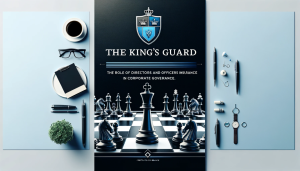The Queen’s Fortress: Cyber insurance at the forefront of strategic defense
In the realm of chess, the board is a kingdom under constant threat, each piece playing a pivotal role in the defense of its territory. This ancient game of strategy mirrors the modern battlefield of cybersecurity, where organizations deploy an array of defenses to protect their digital domain.
The analogy extends deeper when considering the strategic layer provided by cyber insurance, acting as a safeguard for when the inevitable breach or attack occurs. This follow-up article explores the intricate parallels between the defense of a chess kingdom and the cyber defense of an organization, highlighting how cyber insurance plays a crucial role in comprehensive risk management.
The Chessboard: A Kingdom Under Siege
Just as a chessboard is divided into territories controlled by two opposing forces, an organization’s digital landscape is a realm where assets are constantly under threat from cyber adversaries. The king, the most crucial piece, represents the organization’s core assets—data, intellectual property, and critical infrastructure. The queen, with her versatile moves, symbolizes the dynamic and comprehensive strategies deployed in cybersecurity efforts, capable of moving far and wide across the board to neutralize threats.
Pawns: The First Line of Defense
In chess, pawns form the first line of defense, shielding the more valuable pieces from immediate threats. Similarly, basic cybersecurity measures such as firewalls, antivirus software, and regular software updates act as the organization’s pawns. They are the initial barrier against external threats, essential yet expendable in the broader strategy of cyber defense.
Knights and Bishops: Specialized Protection
The knights and bishops move in unique patterns, representing specialized cybersecurity tools and practices. Knights, with their L-shaped moves, symbolize the agility of threat detection systems that identify and mitigate attacks from unexpected directions. Bishops, moving diagonally across the board, reflect the targeted approach of encryption and access control measures, protecting data pathways and ensuring only authorized movements within the network.
The Rook: Structural Defenses
Rooks move straight along rows and columns, embodying the structural defenses within an organization’s cybersecurity framework. These include network segmentation and secure backups—defensive measures that are straightforward yet powerful, creating barriers that compartmentalize and safeguard the kingdom’s assets against lateral movements of cyber adversaries.
The Queen: Cyber Insurance as the Ultimate Defense
Cyber insurance emerges as the queen on the chessboard of cybersecurity strategy. It is the most powerful tool in the arsenal, offering versatile protection against a spectrum of cyber threats. Cyber insurance not only provides a financial safety net in the aftermath of a breach but also supports recovery and restoration efforts. It ensures that even when a breach penetrates the initial defenses, the kingdom—your organization—can recover and rebuild, minimizing downtime and financial loss. In the strategic landscape of chess, the queen stands as the most versatile and powerful piece, capable of moving across the board in any direction to protect, attack, and create opportunities for victory. This unparalleled flexibility and strength draw a compelling parallel to cyber insurance in the realm of cybersecurity. Cyber insurance does not merely act as a financial safety net; it is a multifaceted tool that enters the fray at critical moments, mirroring the queen’s pivotal role on the chessboard. Here’s an expanded look at how cyber insurance mirrors the queen’s capabilities in terms of comprehensive defense and support during a cyber incident:
Entering the Shoes of the Insured
Just as the queen can take the place of any threatened piece on the board, cyber insurance steps into the shoes of the insured organization during a crisis. This means that beyond mere compensation, cyber insurance policies often empower the insurer to actively engage in the incident response process. They may negotiate with ransomware attackers, manage legal liabilities, and undertake measures that would traditionally fall within the purview of the organization, thus acting on behalf of the insured to mitigate damages and navigate the complexities of the incident.
Financial Assistance
The queen’s ability to control vast swathes of the chessboard is akin to the broad financial assistance provided by cyber insurance. This coverage extends beyond simple reimbursement for losses, covering a range of expenses related to a cyber incident. This can include direct costs such as ransom payments in a ransomware attack, legal fees for defending against lawsuits, and regulatory fines that may be levied in the aftermath of data breaches. The financial capabilities of cyber insurance ensure that an organization can recover from an incident without debilitating financial strain.
Crisis Management Team
In chess, the queen often leads the charge in both offense and defense, coordinating with other pieces to fortify positions or launch attacks. Similarly, cyber insurance policies frequently include the services of a crisis management team. This specialized team acts immediately following a cyber incident, employing strategic communication to manage public relations, preserve customer trust, and mitigate reputational damage. Their expertise in crisis communication is crucial in maintaining stakeholder confidence during and after a cyber event.
Forensics Team
The queen’s capacity to uncover vulnerabilities and strike at the heart of the opponent’s strategy is mirrored by the role of a forensics team provided by cyber insurance. Following a cyber incident, this team conducts a thorough investigation to determine the cause, scope, and method of the attack. By analyzing how the breach occurred, the forensics team helps the organization patch vulnerabilities, prevent future incidents, and understand the sequence of events for legal or regulatory compliance purposes.
In the grand strategy of cybersecurity, cyber insurance embodies the queen’s multifaceted role, providing a critical combination of financial support, expertise, and crisis intervention. It ensures that when a cyber incident threatens the kingdom—your organization—the queen can mobilize across the board, offering a comprehensive defense that safeguards the realm’s integrity and future prosperity.
For detailed information on cyber insurance, feel free to visit our website:
A Game of Strategic Foresight
The parallels between chess and cybersecurity underscore the importance of strategic planning, foresight, and the acknowledgment that some threats will inevitably breach the front lines. Cyber insurance provides the resilience and recovery capability necessary to face these threats head-on, ensuring that the kingdom—your organization—remains secure and sovereign over its digital domain.
In the game of cybersecurity, as in chess, the wise deployment of all pieces, culminating in the strategic use of cyber insurance, creates a formidable defense capable of protecting the kingdom from the myriad threats it faces. This integrated approach to cybersecurity and risk management ensures that even in the face of adversity, the organization can emerge victorious, its assets and integrity intact.





